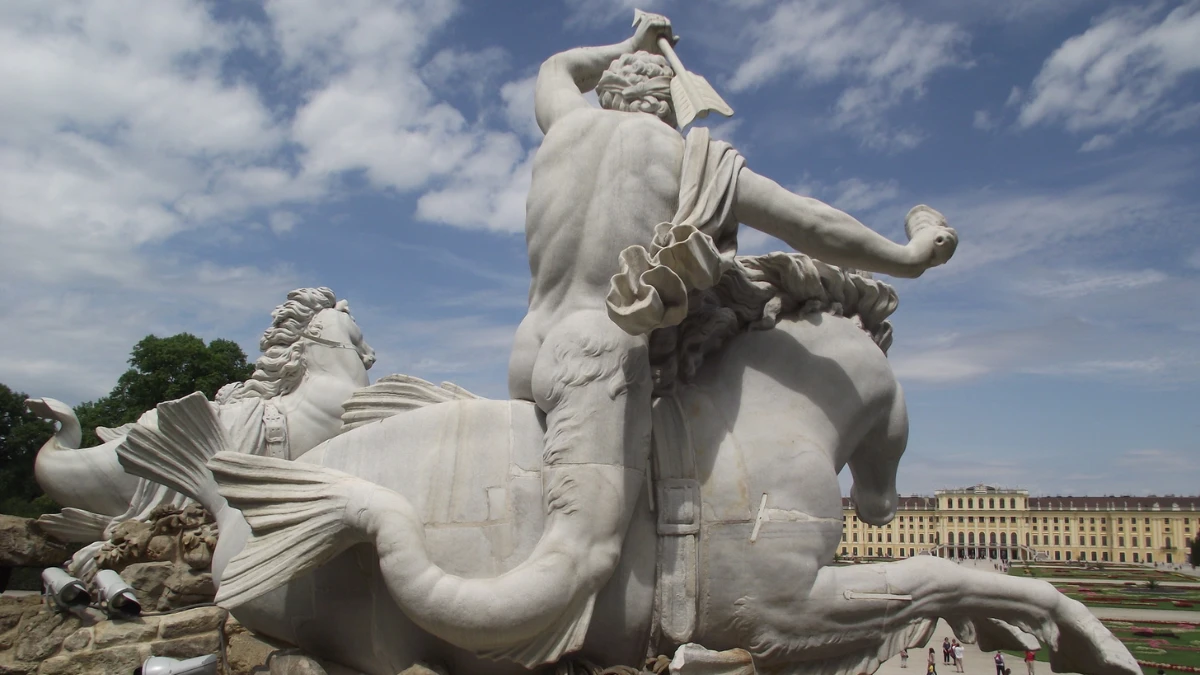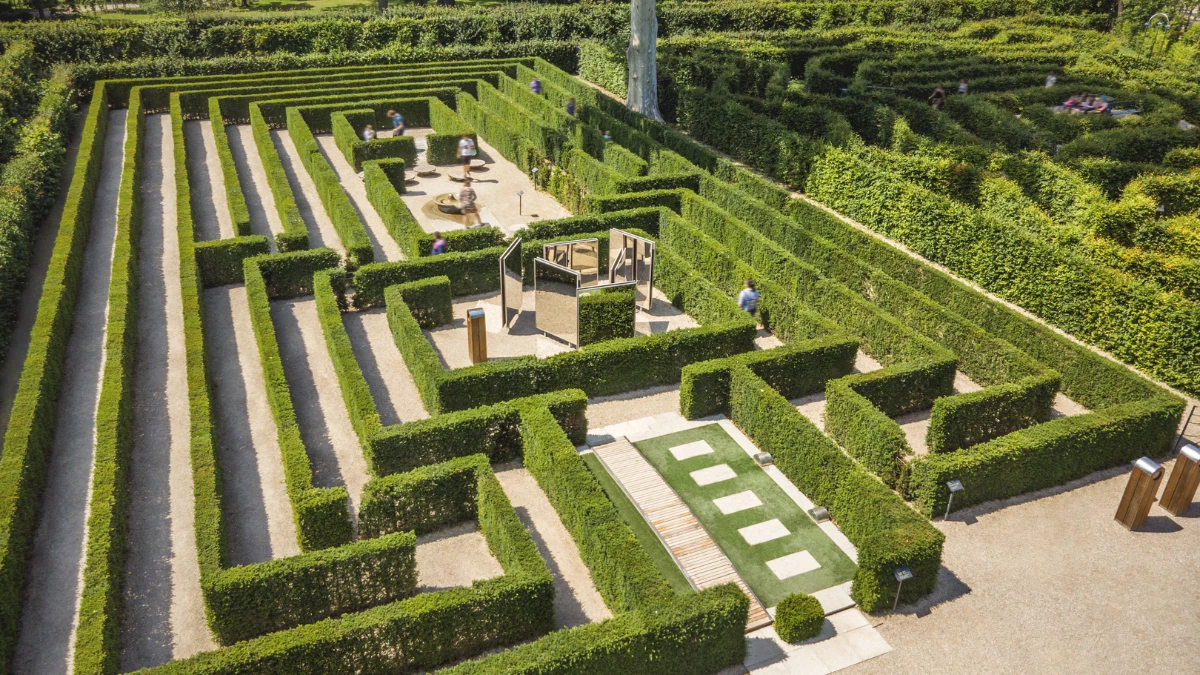What’s Inside Schönbrunn Palace Gardens
Explore Vienna’s imperial gardens step by step

Everyone says, “Don’t skip the Schönbrunn Gardens,” but what they don’t tell you is how massive and confusing it can be.
Stretching over 1.2 km, the gardens are filled with fountains, mazes, scenic hills, and quiet corners, but not all of them are free.
Without a clear plan, it’s easy to wander or miss the best parts.
This guide breaks it all down, covering what to see, what needs a ticket, and how to explore it all without wasting time.
Table of Contents
What are the Schönbrunn Gardens?
The Schönbrunn Gardens are part of the UNESCO-listed Schönbrunn Palace estate and represent one of Europe’s finest Baroque gardens.
The layout features symmetrical paths, majestic fountains, elaborate flower beds, and surprising attractions hidden in groves and on hilltops.
Inside, you’ll find a mix of:
- Free open-air sections with royal grandeur
- Paid attractions like mazes, viewing terraces, and historic greenhouses
Whether you want a peaceful walk, panoramic views, or family fun, there’s something inside for every visitor.
⭐ Also, explore Schonbrunn Palace rooms for a complete visit!
History in layers: How the Schönbrunn gardens evolved over centuries
Understanding the history provides a richer perspective as you walk.
Here’s how Schönbrunn’s gardens came to be:
- 14th century: Originally known as ‘Katterburg,’ it was a monastic estate with vineyards and mills.
- 1569: Emperor Maximilian II bought the estate to build a hunting preserve.
- 1605: The enclosed gardens were destroyed by Hungarian troops.
- 1612: Emperor Matthias allegedly discovered the “schöner Brunnen” (beautiful spring), giving the estate its current name.
- 1642-1683: Empress Eleonora Gonzaga laid out the first formal gardens, which were later destroyed in the Ottoman siege.
- 1696 onwards: Architect Fischer von Erlach began transforming the site into a grand imperial residence.
- 1740-1780 (Maria Theresa’s reign): The gardens were redesigned in the French Baroque style with embroidery-style parterres, monumental fountains, and statues.
- 19th century: Parts of the gardens were redesigned in English landscape style, and the monumental Palm House was added.
👉 For a complete timeline, check our detailed guide on Schönbrunn Palace’s history.
Gardens and outdoor highlights: What you’ll see inside Schönbrunn Gardens
The outdoor area of Schönbrunn Palace is a grand spread of sculpted gardens, tranquil walkways, decorative fountains, and iconic landmarks, most of which are free to explore.
However, a few special areas require a Classic Pass or separate entry tickets.
Here’s what you’ll find:

Great Parterre
A perfectly symmetrical formal garden stretches out from the back of the palace. Lined with sculptures, it forms the grand visual axis that connects the palace to the Gloriette.

Gloriette
Perched atop a hill, this neoclassical arch offers sweeping views over the palace and the Vienna skyline. You can climb up for free or pay to access the rooftop viewing platform and café.

Neptune Fountain
A dramatic Baroque fountain with statues of Neptune and sea creatures. Located just below the Gloriette, it’s a photogenic spot and an anchor point in the palace’s garden axis.

Maze & Labyrinth
Fun for families, this attraction features a hedge maze, playground, and interactive elements. Requires a ticket. Ideal for children or adults looking for a light-hearted challenge.

Orangery
One of the largest Baroque orangeries in Europe. While the interior sometimes hosts classical concerts, the outdoor view of this historic greenhouse is freely accessible.

Crown Prince Garden
A small but elegant ornamental garden next to the palace, known for its symmetry, floral patterns, and trellised walkways. This garden requires a ticket to enter.

Privy Garden
An enclosed formal garden with trimmed hedges, historical layout, and shaded benches. It offers a quieter atmosphere, requires a ticket, and is worth it for peaceful strolls.

Roman Ruin
Artificial ruins were designed in the 18th century to evoke the grandeur of ancient Rome. It’s an excellent photo spot with cascading greenery and romantic vibes.

Obelisk Fountain
A monumental fountain crowned by an obelisk with symbolic hieroglyph-like carvings. Set at the far end of the garden and often missed, a hidden gem for explorers.
👉 Families will also love visiting the Schönbrunn Zoo, which is right inside the garden complex.
Free vs ticketed areas in Schönbrunn Gardens
While much of the Schönbrunn Gardens is free to explore, several highlights require a ticket.
Use the table below to see what’s freely accessible and what needs advance planning.
| Free access areas | Ticketed areas |
| Great Parterre | Maze & Labyrinth |
| Neptune Fountain | Crown Prince Garden |
| Gloriette (base and hill climb) | Privy Garden (Kammergarten) |
| Roman Ruin | Gloriette Rooftop Viewing Platform & Café |
| Obelisk Fountain | Palm House (Interior) |
| Orangery (Exterior view only) | Desert House (Wüstenhaus) |
| Garden paths and tree-lined avenues | Orangery (Interior access via concert ticket) |
| Palm House (Exterior view) |
Even if you don’t buy any tickets, there’s plenty to see for free, but if you want the full Schönbrunn garden experience, it’s worth paying for a few of the hidden gems.
For example, if you’re visiting with young children and not planning to enter the paid Maze area, head to the Kinderspielplatz (children’s playground) located nearby.
It’s free to access, shaded by trees, and equipped with slides, swings, and climbing structures, perfect for a break while the kids burn off some energy.
👉 Want to explore both free and paid parts with ease? Consider a combo ticket that includes gardens, palace, and more.
Best times to visit the gardens (by season, time of day, and weather)
The gardens are open daily from 6.30 am to around dusk, with closing times varying by season.
Most outdoor areas remain accessible until late evening in summer and early evening in winter.
When you visit, it affects what you see and how much you enjoy it.
Here’s how to plan it right:
| Time | Best for | Why it works |
| Early morning | Peace, photos, no crowds | Gates open at 6.30 am, ideal lighting |
| Spring (Apr-May) | Full bloom, fountains on | Flowers, fresh air, and manageable tourist flow |
| Summer (Jun-Aug) | Vibrancy, music, and long days | All attractions are open, but peak crowd hours |
| Autumn (Sep-Oct) | Mild weather, fall colors | Great for photos and fewer tourists |
| Winter (Nov-Feb) | Serenity, snowy charm | No fountains, but peaceful walks and markets |
Tip: Avoid visiting around midday in July and August, as it’s both too hot and overly crowded, especially on weekends after 11 am.
👉 Recommended Read: Schonbrunn Palace opening hours and best time to visit
How to reach the gardens & how much time to spend

Download the Schonbrunn Palace Map (808 kb, PDF), or check our visitor-friendly map guide for easy navigation inside the gardens.
Take metro line U4 to Schönbrunn Station, just a 5-minute walk from the main gate.
Buses like the 10A also stop nearby.
You can enter through the main entrance near the palace or from the east and west side gates, which locals also use.
If you’re short on time, spend 45 to 60 minutes for a quick overview.
To explore everything, including ticketed areas, set aside 2.5 to 3 hours.
👉 Find the best routes to Schönbrunn Palace Gardens. Get maps, metro tips & entry info. Explore it now!
Tips to explore the Schönbrunn Gardens without confusion

Here are some practical tips to help you navigate the gardens with ease:
- Wear comfortable shoes, as you’ll likely walk 2 to 4 kilometers if you want to see everything.
- Start your visit early in the morning or later in the afternoon to avoid heavy crowds near the Neptune Fountain and Gloriette.
- Stick to the shaded paths during summer, especially when walking toward the Roman Ruin and Obelisk Fountain.
- Save the uphill walk to the Gloriette for the end of your visit, so you can relax with a drink at the café.
- Set aside 2 to 3 hours to enjoy most of the outdoor highlights at a relaxed pace.
- Consider a picnic break on the quiet lawns behind the Gloriette hill or near the Roman Ruins.
Get expert tips for exploring Schönbrunn Palace Gardens. Discover routes, timings & secrets.
FAQs: Quick answers about Schönbrunn Gardens
Before you set off for the Gloriette or get lost in the maze (on purpose!), check out these quick answers to common questions about Schönbrunn Gardens.
What’s the best entrance to Schönbrunn Gardens for tourists?
Use the main gate near Schönbrunn Palace. It’s closest to the metro and ideal for starting with the palace courtyard, formal gardens, and heading uphill toward the Gloriette.
Can I visit Schönbrunn Gardens early in the morning?
Yes, the gardens open as early as 6.30 am daily, making it perfect for a peaceful walk before crowds arrive, especially in summer. Most ticketed sections open later in the morning.
Are Schönbrunn Gardens open during winter?
Yes, the gardens are open year-round, but fountains are turned off and some attractions like the maze may close during winter months. Paths are still walkable and offer a scenic snowy experience.
Do I need to reserve Schönbrunn Garden tickets in advance?
You don’t need tickets for the free garden areas. But if you’re visiting the Maze, Orangery Garden, or Desert House, it’s best to book online to skip lines and check seasonal hours.
Can I bring a stroller into Schönbrunn Gardens?
Yes, strollers are allowed throughout the gardens. Most paths are paved and easy to navigate, though some uphill sections like to the Gloriette may require more effort.
Is Schönbrunn Gardens good for kids?
Absolutely. Children enjoy the Maze, playgrounds, fountains, and large open spaces. It’s stroller-friendly and offers many shaded areas for breaks or snacks.
Are there benches and resting areas in Schönbrunn Gardens?
Yes, there are plenty of benches and shaded spots throughout the park, especially around fountains, near the Gloriette, and along the tree-lined walkways.
Can I access Schönbrunn Zoo from the gardens?
Yes, the Schönbrunn Zoo is within the garden complex. You can walk there easily from the main garden paths, but you’ll need a separate ticket to enter the zoo itself.
Do I need a map to explore Schönbrunn Gardens?
It’s not required, but a map or mobile guide helps if you want to see all highlights without backtracking, especially in larger sections like the Roman Ruin, Obelisk Fountain, and Gloriette.
Are bikes or scooters allowed inside the gardens?
No, bicycles, scooters, and skateboards are not permitted inside the garden paths to preserve the historic grounds and ensure the safety of all visitors.
